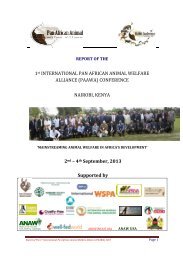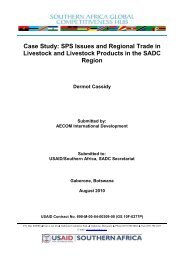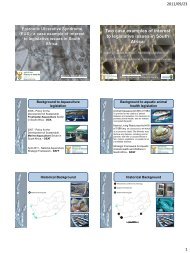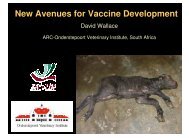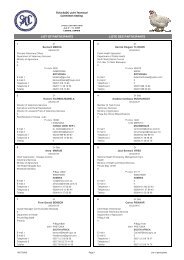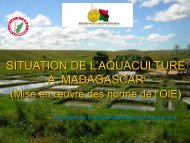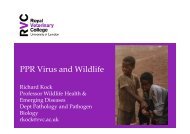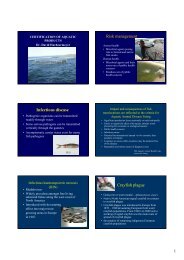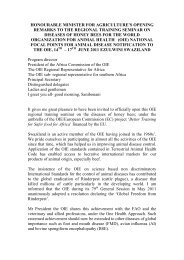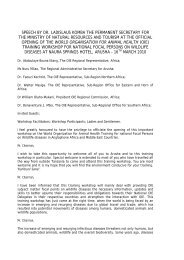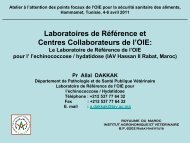OFFLU review of avian influenza surveillance and ... - OIE Africa
OFFLU review of avian influenza surveillance and ... - OIE Africa
OFFLU review of avian influenza surveillance and ... - OIE Africa
You also want an ePaper? Increase the reach of your titles
YUMPU automatically turns print PDFs into web optimized ePapers that Google loves.
<strong>OFFLU</strong> <strong>review</strong> <strong>of</strong> <strong>avian</strong> <strong>influenza</strong> <strong>surveillance</strong> <strong>and</strong><br />
epidemiological projects in some European, <strong>Africa</strong>n,<br />
<strong>and</strong> Asian countries<br />
Gounalan Pavade, Laure Weber‐Vintzel, Keith Hamilton, Alain Dehove,<br />
Cristóbal Zepeda<br />
Introduction<br />
Summary<br />
This <strong>review</strong> aims to examine approaches to <strong>avian</strong> <strong>influenza</strong> <strong>surveillance</strong> <strong>and</strong><br />
epidemiological projects in some European, <strong>Africa</strong>n, <strong>and</strong> Asian countries.<br />
Information about projects in these regions was gathered by means <strong>of</strong> a<br />
questionnaire sent to <strong>OIE</strong> <strong>and</strong> FAO regional <strong>of</strong>fices.<br />
Objectives for <strong>surveillance</strong> <strong>and</strong> epidemiology projects appear to vary between<br />
different regions, with a trade focus in European countries <strong>and</strong> a development focus<br />
in <strong>Africa</strong>n countries. The limited numbers <strong>of</strong> responses from Asian countries suggest<br />
that an objective <strong>of</strong> <strong>surveillance</strong> in this region is to underst<strong>and</strong> the role <strong>of</strong> the<br />
environment in the epidemiology <strong>of</strong> <strong>avian</strong> <strong>influenza</strong>. Implementation <strong>and</strong> funding<br />
mechanisms also vary between the regions, with many <strong>Africa</strong>n projects being funded<br />
by external donors. The <strong>review</strong> raised questions about the longer term sustainability<br />
<strong>of</strong> AI <strong>surveillance</strong> projects, particularly in <strong>Africa</strong>. The responses also suggested that<br />
investments in <strong>surveillance</strong> <strong>and</strong> good veterinary governance play a broader role in<br />
capacity building.<br />
The questionnaire based survey was initiated <strong>and</strong> overseen by the <strong>OFFLU</strong> applied<br />
epidemiology group. <strong>OFFLU</strong> is the joint <strong>OIE</strong>‐FAO global network <strong>of</strong> expertise on<br />
animal <strong>influenza</strong>s, <strong>and</strong> the applied epidemiology group is a small working group <strong>of</strong><br />
leading epidemiologists with specialist expertise in <strong>avian</strong> <strong>influenza</strong>.<br />
Between 2005 <strong>and</strong> 2010 H5N1 highly pathogenic <strong>avian</strong> <strong>influenza</strong> (HPAI) spread rapidly to over 60 countries on<br />
three continents. National <strong>and</strong> regional <strong>avian</strong> <strong>influenza</strong> <strong>surveillance</strong> programmes <strong>and</strong> reporting <strong>of</strong> disease<br />
outbreaks to the World Organisation for Animal Health (<strong>OIE</strong>) have enabled the international community to<br />
monitor the global disease situation <strong>and</strong> target their interventions accordingly.<br />
H5N1 HPAI <strong>and</strong> other notifiable <strong>avian</strong> <strong>influenza</strong>s remain a significant threat to animal health <strong>and</strong> welfare, public<br />
health, agricultural productivity, economies <strong>and</strong> the livelihoods <strong>of</strong> some <strong>of</strong> the world’s poorest farmers. In<br />
2011 H5N1 HPAI remains enzootic or entrenched in several areas, <strong>and</strong> countries continue to report<br />
reoccurrences <strong>of</strong> outbreaks (<strong>OIE</strong>‐WAHID). The disease continues to have a significant impact on poultry health<br />
<strong>and</strong> causes significant economic losses through restricted production <strong>and</strong> trade.<br />
As well as causing devastating losses to animal health, H5N1 HPAI is an important zoonosis with a high case<br />
fatality rate, <strong>and</strong> like other animal <strong>influenza</strong> viruses there is potential for it to evolve into a p<strong>and</strong>emic virus<br />
1
(WHO, 2010). It is well acknowledged that to reduce direct zoonotic risks from H5N1 HPAI it is best to control<br />
the virus in the poultry source. Early detection allows a more rapid <strong>and</strong> effective response keeping losses in the<br />
agriculture sector to a minimum, <strong>and</strong> significantly reducing public health threats. Effective <strong>surveillance</strong> vastly<br />
improves the chances <strong>of</strong> early disease detection, informs control strategies so that interventions can be<br />
targeted properly, <strong>and</strong> allows monitoring <strong>of</strong> the disease situation so that a body <strong>of</strong> evidence can be gathered to<br />
eventually self‐declare freedom from disease for trade purposes (K.Hamilton <strong>and</strong> G.Bruckner, 2010).<br />
Surveillance generates important data about the characteristics <strong>of</strong> virus, allowing scientists to detect emerging<br />
public <strong>and</strong> animal health threats early, <strong>and</strong> better describe the epidemiology <strong>of</strong> the disease.<br />
In response to HPAI H5N1 donor funds from international agencies have been mobilised on a large scale to<br />
improve capacity for <strong>avian</strong> <strong>influenza</strong> <strong>surveillance</strong> <strong>and</strong> response. This has resulted in unprecedented levels <strong>of</strong><br />
<strong>avian</strong> <strong>influenza</strong> <strong>surveillance</strong> programmes world‐wide, including both poultry <strong>and</strong> wild birds. Surveillance has<br />
been undertaken by a range <strong>of</strong> bodies including national governments, international organisations, research<br />
institutions, NGOs, <strong>and</strong> regional organisations.<br />
There are various approaches to <strong>avian</strong> <strong>influenza</strong> <strong>surveillance</strong> <strong>and</strong> these are <strong>of</strong>ten adapted to the local setting<br />
<strong>and</strong> resources available. The <strong>OFFLU</strong> Applied Epidemiology Technical Activity decided to gather information to<br />
compare <strong>and</strong> contrast approaches to <strong>avian</strong> <strong>influenza</strong> <strong>surveillance</strong> in different regions, <strong>and</strong> to identify gaps <strong>and</strong><br />
areas <strong>of</strong> overlap.<br />
Methodology<br />
In April 2009 the <strong>OFFLU</strong> Applied Epidemiology Technical Activity designed a questionnaire to collect<br />
information about objectives, funding, duration, <strong>and</strong> institutes involved in AI <strong>surveillance</strong> globally for the<br />
period 2005–2009. This was sent to <strong>OIE</strong> <strong>and</strong> FAO Regional Offices by email.<br />
The questionnaire was completed by the <strong>OIE</strong>/FAO Regional Representations in Europe <strong>and</strong> <strong>Africa</strong>, <strong>and</strong><br />
responses from Asian countries were coordinated by the FAO AI network for Asia. Although the response rate<br />
varied from region to region, sufficient data were received from <strong>Africa</strong> <strong>and</strong> Europe <strong>and</strong>, to a lesser degree, from<br />
some Asian countries to allow comparisons to be made.<br />
Data received from respondents in <strong>Africa</strong>, Europe, <strong>and</strong> some Asian countries were summarised <strong>and</strong> described.<br />
Information about outbreaks <strong>of</strong> notifiable AI was sourced from the <strong>OIE</strong> World Animal Health Information<br />
Database.<br />
Broad findings <strong>of</strong> a needs assessment carried out in 26 sub‐saharan <strong>Africa</strong>n countries called the Integrated<br />
National Action Program on Avian <strong>and</strong> Human Influenza (INAP) were also considered with responses from<br />
<strong>Africa</strong>. These findings include an analysis <strong>of</strong> veterinary <strong>and</strong> public governance <strong>of</strong> the 26 beneficiary countries.<br />
Results<br />
The responses received from the European, <strong>Africa</strong>n <strong>and</strong> Asian countries have been summarised along with<br />
information about outbreaks <strong>of</strong> AI in respective countries retrieved from the World Animal Health Information<br />
Database (WAHID).<br />
Summary <strong>of</strong> responses from the <strong>OIE</strong> European Region:<br />
2
1. Information about AI <strong>surveillance</strong> <strong>and</strong> epidemiological activities were received from 23 <strong>of</strong> the<br />
53 countries in the <strong>OIE</strong> European region, 16 <strong>of</strong> these countries are members <strong>of</strong> the European Union<br />
(EU).<br />
2. Of the 23 European countries, seven countries have reported HPAI in poultry <strong>and</strong> 14 countries have<br />
reported HPAI in wild birds during the period 2005–2009. (Source: WAHID, <strong>OIE</strong>). The subtype reported<br />
in all <strong>of</strong> these outbreaks is H5N1. Six countries have also reported LPAI (low pathogenicity AI) in<br />
poultry.<br />
3. All European respondents have a national <strong>surveillance</strong> <strong>and</strong> epidemiological programme for AI in<br />
poultry <strong>and</strong> wild birds.<br />
4. For the European country respondents, most countries received funding for AI <strong>surveillance</strong> from their<br />
governments, <strong>and</strong> in the case <strong>of</strong> EU countries co‐funding from the EU. The following countries that<br />
responded <strong>and</strong> are in the <strong>OIE</strong> European region receive funding for <strong>surveillance</strong> from external donors:<br />
Armenia ‐ FAO, World Bank <strong>and</strong> Japanese Funding programme;<br />
Azerbaijan ‐ FAO;<br />
Bosnia <strong>and</strong> Herzegovina ‐ National fund, FAO <strong>and</strong> World Bank;<br />
Turkey ‐ World Bank loan, European Union (EU), United States Agency for International<br />
Development (USAID), National fund <strong>and</strong> beneficiaries.<br />
5. The <strong>surveillance</strong> <strong>and</strong> epidemiological programmes in European countries are on‐going, usually having<br />
annual duration <strong>and</strong> are renewed every year.<br />
6. The stated objectives <strong>of</strong> <strong>surveillance</strong> for AI in poultry in the European countries are:<br />
<br />
<br />
To detect subclinical infections <strong>of</strong> notifiable LPAI virus <strong>and</strong><br />
To detect HPAI virus, contributing to the demonstration <strong>of</strong> free status in conformity with<br />
international trade regulations.<br />
The <strong>surveillance</strong> programmes follow general (passive) <strong>and</strong> targeted (active) types <strong>of</strong> <strong>surveillance</strong>. This<br />
includes investigation <strong>and</strong> diagnostic testing following disease suspicion (virological testing), <strong>and</strong> also a<br />
structured annual serological survey targeted to all species <strong>of</strong> poultry (breeders, layers, turkeys, ducks,<br />
partridges, quails, ostriches etc). In the annual survey, if serology is positive it is followed by virological<br />
testing.<br />
7. The objective <strong>of</strong> <strong>surveillance</strong> in wild birds is to detect LPAI <strong>and</strong> HPAI virus in higher risk species <strong>of</strong> wild<br />
birds <strong>and</strong> those living in close proximity to domestic poultry, <strong>and</strong> also from hunted game birds. The<br />
<strong>surveillance</strong> programmes follow general (passive) <strong>and</strong> targeted (active) types <strong>of</strong> <strong>surveillance</strong>.<br />
Surveillance programmes for wild birds always involves virological <strong>surveillance</strong>. Anseriformes (water<br />
fowl) <strong>and</strong> Charadriiformes (shorebirds <strong>and</strong> gulls) are the main sampling targets. Active <strong>surveillance</strong> is<br />
conducted on living <strong>and</strong> clinically healthy <strong>and</strong>/or clinically diseased, injured or hunted birds. Cloacal<br />
swabs/fresh faeces <strong>and</strong> tracheal/oropharyngeal samples are collected. Passive <strong>surveillance</strong> is<br />
conducted on sick <strong>and</strong> dead wild birds. Cloacal <strong>and</strong> tracheal/oropharyngeal swabs <strong>and</strong>/or tissues<br />
namely the brain, heart, lung, trachea, kidney <strong>and</strong> intestines are collected for virus isolation <strong>and</strong><br />
molecular detection.<br />
8. All laboratory tests are carried out in accordance with Chapter 2.3.4 on HPAI <strong>of</strong> the <strong>OIE</strong> Manual <strong>of</strong><br />
Diagnostic Tests <strong>and</strong> Vaccines for Terrestrial Animals, Sixth Edition 2008, <strong>OIE</strong> <strong>and</strong> Commission Decision<br />
3
2006/437/EC approving a Diagnostic Manual for <strong>avian</strong> <strong>influenza</strong> as provided for in Council Directive<br />
2005/94/EC.<br />
9. An international research project entitled “Constanze” was conducted in which researchers from three<br />
countries, namely Germany, Austria <strong>and</strong> Switzerl<strong>and</strong> bordering Lake Constance, studied AI in relation<br />
to wild birds in that region. Since the start <strong>of</strong> the project in September 2006, a total <strong>of</strong> 778 wild birds<br />
have been sampled, 329 <strong>of</strong> them in Switzerl<strong>and</strong>, 369 in Germany <strong>and</strong> 80 in Austria. LPAI viruses <strong>of</strong><br />
different subtypes were detected in 29 <strong>of</strong> these birds. But there was no detection <strong>of</strong> H5N1 HPAI.<br />
10. Germany <strong>and</strong> the Netherl<strong>and</strong>s have reported carrying out preventive vaccination against HPAI, while<br />
Portugal, France, <strong>and</strong> Italy have reported carrying out vaccination against LPAI. (Info on all approved<br />
vaccination plans in the EU:<br />
http://ec.europa.eu/food/animal/diseases/controlmeasures/<strong>avian</strong>/eu_resp_vaccination_en.htm )<br />
Summary <strong>of</strong> responses from the <strong>Africa</strong>n Region:<br />
1. Information about AI <strong>surveillance</strong> <strong>and</strong> epidemiological activities were received from 53 <strong>Africa</strong>n<br />
countries, 51 <strong>of</strong> which are in the <strong>OIE</strong> Region for <strong>Africa</strong><br />
2. Of the 53 <strong>Africa</strong>n countries, 13 countries have reported HPAI in poultry <strong>and</strong> three countries have<br />
reported HPAI in wild birds during the period 2005–2009 (Source: WAHID, <strong>OIE</strong>). The subtypes involved<br />
in all these outbreaks have mainly been H5N1 <strong>and</strong>, on one occasion, H5N2. There were no reports <strong>of</strong><br />
LPAI.<br />
3. The <strong>surveillance</strong> <strong>and</strong> epidemiological projects on AI are regional wherein a single project covers 4, 6,<br />
15 or 47 countries (Fig.1 <strong>and</strong> Fig. 2). The various <strong>surveillance</strong> <strong>and</strong> epidemiological projects in <strong>Africa</strong> are<br />
tabulated as below.<br />
4. <strong>Africa</strong>n countries undertake AI <strong>surveillance</strong> programmes <strong>and</strong> are supported financially by external<br />
agencies including the EU/World Bank/USAID/ French Ministry <strong>of</strong> Foreign <strong>and</strong> European Affairs etc.<br />
5. The duration <strong>of</strong> <strong>surveillance</strong> programmes in <strong>Africa</strong>n countries varies from 1 to 3 years; some <strong>of</strong> them<br />
have already been completed, others are due to be completed in 2010.<br />
6. Objectives <strong>of</strong> <strong>surveillance</strong> programmes in <strong>Africa</strong>n countries are reported to involve strengthening<br />
capacity for HPAI <strong>surveillance</strong>, preparedness, <strong>and</strong> response.<br />
The activities <strong>of</strong> AI <strong>surveillance</strong> programmes followed in most <strong>Africa</strong>n countries include:<br />
a. Training field staff in disease diagnosis,<br />
b. Training in sampling <strong>and</strong> <strong>surveillance</strong> techniques,<br />
c. Supply <strong>of</strong> reagents to all national laboratories through dem<strong>and</strong>–supply hub for performing<br />
serological <strong>surveillance</strong> on poultry,<br />
d. Creating awareness among the target groups about the disease through pamphlets, posters,<br />
booklets <strong>and</strong> T‐shirts, <strong>and</strong><br />
e. Implementation <strong>of</strong> scanning, active <strong>and</strong> passive <strong>surveillance</strong> through development <strong>of</strong><br />
<strong>surveillance</strong> guidelines <strong>and</strong> harmonised data capture forms for HPAI <strong>surveillance</strong>.<br />
7. In two projects, namely GRIPAVI <strong>and</strong> OSRO/RAF/811/ILR, the AI <strong>surveillance</strong> programme is linked with<br />
the <strong>surveillance</strong> <strong>of</strong> Newcastle disease.<br />
4
8. Apart from South <strong>Africa</strong> <strong>and</strong> Zimbabwe, no information was provided about wild bird <strong>surveillance</strong> in<br />
other <strong>Africa</strong>n countries, although it is known to take place.<br />
9. Routine vaccination against HPAI has been reported in Egypt from year 2006 onwards in birds. Also<br />
the Sudan <strong>and</strong> Niger have reported preventive vaccination against HPAI in birds in 2006 <strong>and</strong> 2007,<br />
respectively.<br />
Summary <strong>of</strong> responses from the Asian Region:<br />
1. Information about AI <strong>surveillance</strong> <strong>and</strong> epidemiological activities were received from seven countries <strong>of</strong><br />
the 35 in the <strong>OIE</strong> Region for Asia, the Far East, <strong>and</strong> Oceania; these were Bangladesh, Cambodia,<br />
People’s Republic <strong>of</strong> China, Myanmar, Nepal, Thail<strong>and</strong> <strong>and</strong> Vietnam.<br />
2. All seven countries have reported HPAI in poultry <strong>and</strong> two countries (China <strong>and</strong> Vietnam) have<br />
reported HPAI in wild birds during the period 2005–2009. The subtype reported in all <strong>of</strong> these<br />
outbreaks was H5N1. One country has also reported LPAI in poultry.<br />
3. The <strong>surveillance</strong> <strong>and</strong> epidemiological projects on AI are national as well as regional covering 2–<br />
3 countries. The various projects in Asian countries are as follows.<br />
4. Epidemiological <strong>and</strong> <strong>surveillance</strong> programmes are supported financially by external agencies such as<br />
French Ministry <strong>of</strong> Foreign <strong>and</strong> European Affairs, CIRAD, EU, United Nations, USAID, Avian <strong>and</strong> Human<br />
Influenza Facility (AHIF), AusAID, World Bank, etc.<br />
5. All the <strong>surveillance</strong> programmes in Asian countries are on‐going <strong>and</strong> the duration varies from 2 to<br />
5 years.<br />
6. The objectives <strong>of</strong> the <strong>surveillance</strong> <strong>and</strong> epidemiological programmes are reported to involve<br />
underst<strong>and</strong>ing the role <strong>of</strong> the environment in the survival <strong>of</strong> the virus <strong>and</strong> in the re‐emergence <strong>of</strong><br />
outbreaks; quantitative assessment <strong>of</strong> AI <strong>surveillance</strong> systems; epidemiology <strong>and</strong> ecology <strong>of</strong> AI in local<br />
areas <strong>and</strong> capacity building for prevention <strong>and</strong> control <strong>of</strong> HPAI.<br />
7. The activities <strong>of</strong> AI <strong>surveillance</strong> programmes followed in Asian countries include:<br />
a. Active <strong>and</strong> passive <strong>surveillance</strong> in poultry <strong>and</strong> wild birds,<br />
b. Laboratory <strong>and</strong> epidemiology capacity building,<br />
c. Training <strong>of</strong> technicians <strong>and</strong> field personnel to monitor AI,<br />
d. Retrospective studies <strong>of</strong> the determinants <strong>of</strong> H5N1 outbreaks,<br />
e. Ecology <strong>of</strong> the AI virus.<br />
8. Vaccination against HPAI has been reported by Vietnam in 2006 <strong>and</strong> 2007.<br />
Discussion<br />
There was a variable response rate to the questionnaire. Information about AI <strong>surveillance</strong> <strong>and</strong> epidemiological<br />
projects was received from all countries in the <strong>Africa</strong>n continent, from 23 countries (50%) in the <strong>OIE</strong> European<br />
region <strong>and</strong> from only 7 Asian countries. Most <strong>of</strong> the European country responses are from EU members <strong>and</strong><br />
therefore, for the European countries, there is a bias towards EU data <strong>and</strong> policy.<br />
Of the countries covered by the questionnaire responses, all the Asian countries <strong>and</strong> 25–30% <strong>of</strong> the European<br />
<strong>and</strong> <strong>Africa</strong>n countries had reported outbreaks <strong>of</strong> HPAI in poultry to the <strong>OIE</strong> during the period 2005–2009 (<strong>OIE</strong>‐<br />
WAHID). A larger proportion <strong>of</strong> European countries (60%) reported outbreaks <strong>of</strong> HPAI in wild birds than <strong>Africa</strong>n<br />
5
countries (5%) (Fig.3). In line with the global trend, <strong>and</strong> as illustrated in Figures 4 <strong>and</strong> 5, the European <strong>and</strong><br />
<strong>Africa</strong>n countries reported a decreasing trend in the number <strong>of</strong> HPAI outbreaks in poultry <strong>and</strong> wild birds<br />
between 2006 <strong>and</strong> 2009.<br />
There was variability in the geographical coverage <strong>of</strong> <strong>surveillance</strong> projects among the different regions. All<br />
European countries had national <strong>surveillance</strong> programmes for AI whilst in <strong>Africa</strong>, the <strong>surveillance</strong> programmes<br />
were all implemented at a regional level covering 4, 6, 15, or 47 countries. Both national <strong>and</strong> regional<br />
<strong>surveillance</strong> programmes were reported from the Asian countries.<br />
Most <strong>of</strong> the European countries are members <strong>of</strong> the EU where all <strong>surveillance</strong> programmes are co‐funded by<br />
the national government <strong>and</strong> the European Union (EU). The funding situation is different in <strong>Africa</strong> <strong>and</strong> the 7<br />
Asian countries, where <strong>surveillance</strong> is funded by international donors. The programmes in <strong>Africa</strong> rely on fixedterm<br />
financial commitment. Continuation <strong>of</strong> <strong>surveillance</strong> in the <strong>Africa</strong>n <strong>and</strong> Asian countries will depend on<br />
availability <strong>of</strong> external donor funds <strong>and</strong> longer term donor commitment.<br />
Participatory disease <strong>surveillance</strong> was reported to take place in 15 countries in <strong>Africa</strong> <strong>and</strong> was not reported for<br />
the Asian or European countries, although it is known to contribute to AI <strong>surveillance</strong> in Indonesia.<br />
The <strong>surveillance</strong> <strong>and</strong> epidemiological programmes in Europe had a focus on disease detection, agent<br />
characterisation <strong>and</strong> self‐declaration <strong>of</strong> disease freedom for trade purposes. The responses for <strong>Africa</strong>n<br />
countries implied that objectives for projects in these countries were also focused on capacity building, raising<br />
social awareness <strong>of</strong> the disease <strong>and</strong> risks, <strong>and</strong> minimising the socio‐economic impact <strong>of</strong> HPAI.<br />
Several <strong>of</strong> the countries covered by the questionnaire were using vaccination as part <strong>of</strong> their control strategy.<br />
This can present certain challenges, particularly with respect to serological <strong>surveillance</strong>. In such instances<br />
<strong>surveillance</strong> strategies should be able to identify infected vaccinated birds from non‐infected vaccinated birds.<br />
Ad hoc wild bird <strong>surveillance</strong> projects were also reported from Europe, where a collaborative project involving<br />
Germany, Switzerl<strong>and</strong> <strong>and</strong> Austria surveyed wild birds for LPAI <strong>and</strong> HPAI around Lake Constance.<br />
An assessment <strong>of</strong> <strong>avian</strong> <strong>influenza</strong> control <strong>and</strong> p<strong>and</strong>emic preparedness in <strong>Africa</strong> called Integrated National<br />
Action Program on Avian <strong>and</strong> Human Influenza (INAP) has been implemented in 26 <strong>Africa</strong>n countries from<br />
2006‐2009 by the <strong>Africa</strong> Livestock Partnership (ALive), in collaboration with FAO, <strong>OIE</strong>, WHO‐AFRO, <strong>and</strong> AU‐<br />
IBAR. INAP identified weak <strong>surveillance</strong> <strong>and</strong> insufficient laboratory capacity to be the most serious concerns in<br />
the ability <strong>of</strong> countries to deal with H5N1 HPAI outbreaks or a p<strong>and</strong>emic. With underinvestment from national<br />
governments, there will be implications for sustainable <strong>avian</strong> <strong>influenza</strong> <strong>surveillance</strong> (INAP, 2010). The INAP<br />
conclusions corroborate the findings <strong>of</strong> the <strong>OFFLU</strong> study.<br />
Conclusions<br />
The findings <strong>of</strong> this <strong>OFFLU</strong> study suggest that <strong>surveillance</strong> for <strong>avian</strong> <strong>influenza</strong> in <strong>Africa</strong>, <strong>and</strong> veterinary<br />
governance are heavily dependent on donor investment. It would appear that some countries in <strong>Africa</strong> have<br />
support for AI <strong>surveillance</strong> from a greater number <strong>of</strong> donor agencies than others. <strong>Africa</strong>n countries receiving<br />
support from more donors are clustered in the southern <strong>Africa</strong>n region <strong>and</strong> North West <strong>Africa</strong>. Countries in<br />
Central <strong>and</strong> South West <strong>Africa</strong> receive less support. The disparity may lead to a bias in <strong>surveillance</strong> favouring<br />
countries receiving more funds. The reasons for the disparity are not clear, <strong>and</strong> it is not known whether it is<br />
based on risk. There are technical <strong>and</strong> economic advantages to targeting <strong>surveillance</strong> to higher risk areas,<br />
particularly when resources are limited, <strong>and</strong> targeting may also contribute to sustainability. In an environment<br />
where multiple donor agencies are funding <strong>surveillance</strong>, coordination is needed to prevent duplication <strong>of</strong><br />
efforts <strong>and</strong> investments in some areas, leaving gaps in others.<br />
6
The degree <strong>and</strong> approach to regional coordination <strong>of</strong> <strong>surveillance</strong> activities varies in different regions. In the EU<br />
a regional strategy is agreed by all member states <strong>and</strong> is prescribed in European legislation. Such legislation<br />
covers survey design <strong>and</strong> funding, provides powers for implementation, <strong>and</strong> ensures harmonisation <strong>of</strong> national<br />
programmes. Technical support <strong>and</strong> analysis <strong>of</strong> survey results are provided by the EU Reference Laboratory. In<br />
<strong>Africa</strong> multiple programmes are implemented on a regional basis, with each covering several countries.<br />
Coordination <strong>of</strong> <strong>surveillance</strong> in <strong>Africa</strong> will present greater challenges with multiple donor agencies providing<br />
financial support <strong>and</strong> no one body providing a central coordination role. The EU survey for AI could be used as<br />
a model for regional coordination. The central administrative role played by the EC ensures that national<br />
programmes are coordinated in line with a regional strategy. EC legislation ensures that countries have the<br />
legal power to enable them to implement <strong>surveillance</strong>, that funding is maintained, <strong>and</strong> that national survey<br />
design is harmonised. The principle <strong>of</strong> having one Reference Laboratory that provides technical support <strong>and</strong><br />
coordination to regional <strong>surveillance</strong> allows data to be centralised, leading to a more comprehensive <strong>and</strong><br />
meaningful epidemiological analysis. The centralised Reference Laboratory also creates a regional virus<br />
repository necessary for further characterisation <strong>of</strong> viruses, <strong>and</strong> development <strong>of</strong> effective diagnostic tests <strong>and</strong><br />
vaccines.<br />
During 2005–2009 reports to the <strong>OIE</strong> demonstrate that subtypes <strong>of</strong> HPAI <strong>and</strong> LPAI other than H5N1 are<br />
circulating in poultry in different parts <strong>of</strong> the world, highlighting the need to maintain <strong>surveillance</strong> for all<br />
notifiable <strong>avian</strong> <strong>influenza</strong>s (HPAI <strong>and</strong> LPAIs H5 <strong>and</strong> H7). From the questionnaire results it appears that AI<br />
<strong>surveillance</strong> in <strong>Africa</strong> is focused on HPAI in poultry, whilst in the European region <strong>and</strong> Asia, <strong>surveillance</strong> covers<br />
all AI subtypes H5 <strong>and</strong> H7 <strong>and</strong> includes a component <strong>of</strong> wild bird <strong>surveillance</strong> in all countries that responded.<br />
Some countries also take the opportunity to include <strong>surveillance</strong> for Newcastle disease in their AI <strong>surveillance</strong><br />
programme. Newcastle disease is a significant poultry health problem, is a threat to food security in many<br />
countries, a barrier to trade, <strong>and</strong> is also a differential diagnosis for AI. Newcastle disease <strong>surveillance</strong> can be<br />
integrated into AI <strong>surveillance</strong> programmes <strong>and</strong> will provide additional benefits, particularly in areas where the<br />
disease is enzootic. However relatively few AI <strong>surveillance</strong> projects in <strong>Africa</strong> appeared to integrate Newcastle<br />
disease <strong>surveillance</strong> <strong>and</strong> it would appear that an opportunity is being missed.<br />
Objectives <strong>of</strong> <strong>surveillance</strong> programmes vary depending on the regional context. Whilst <strong>surveillance</strong> in the<br />
European countries has a primary focus on early detection, control <strong>and</strong> maintaining international trade by<br />
demonstrating country freedom, in <strong>Africa</strong> there is also a focus on development, training, <strong>and</strong> awarenessraising,<br />
<strong>and</strong> this was also reflected in responses from Asia where the disease has been entrenched in several<br />
countries. It is evident that investments in <strong>surveillance</strong> also play a significant role in providing longer term<br />
benefits for development <strong>and</strong> capacity building <strong>and</strong> for sustaining <strong>surveillance</strong> networks.<br />
With H5N1 HPAI remaining enzootic or entrenched in at least three areas <strong>of</strong> the world there is a need to<br />
maintain effective <strong>surveillance</strong> world‐wide to allow monitoring <strong>of</strong> the virus <strong>and</strong> its characteristics, <strong>and</strong> to<br />
facilitate early detection <strong>and</strong> effective control. Sustainability <strong>of</strong> existing <strong>surveillance</strong> programmes will be a key<br />
factor in achieving this. In <strong>Africa</strong> <strong>and</strong> Asia it appears that <strong>surveillance</strong> is supported by external donor funding,<br />
<strong>and</strong> sustainability <strong>of</strong> these programmes is therefore dependent upon renewal <strong>of</strong> funds. It is not clear what will<br />
happen when funding for many <strong>of</strong> these programmes comes to an end in 2011. If funds are not renewed there<br />
is a risk that activities will cease, leading to gaps in global AI <strong>surveillance</strong>. This may also impact essential<br />
infrastructure such as veterinary laboratories <strong>and</strong> human resources that have also been supported directly or<br />
indirectly by AI <strong>surveillance</strong> funds.<br />
Globally there has been considerable investment <strong>and</strong> interest in <strong>surveillance</strong> for H5N1 HPAI over the past<br />
5 years owing primarily to its p<strong>and</strong>emic potential; studies such as INAPs reveal that despite this in parts <strong>of</strong><br />
<strong>Africa</strong> these investments were still not sufficient. In 2010 as the world emerges from an H1N1 p<strong>and</strong>emic <strong>and</strong><br />
many governments are faced with economic uncertainties, the animal health sector faces challenges in<br />
7
sustaining these activities <strong>and</strong> meeting new <strong>and</strong> emerging threats. A similar <strong>review</strong> <strong>of</strong> <strong>surveillance</strong> activity in 3–<br />
4 years may provide a different picture, this is something that the <strong>OFFLU</strong> intends to take forward.<br />
8
Fig.1: Countries integrated in the SPINAP‐AHI project<br />
Fig. 2: Countries integrated in the other projects<br />
9
* 23 European, 53 <strong>Africa</strong>n <strong>and</strong> 7 Asian countries that have sent their responses<br />
10
References:<br />
<strong>OIE</strong>‐WAHID. World Animal Health Information Database.<br />
http://www.oie.int/wahis/public.phppage=home<br />
WHO, 2010. World Health Organization. Cumulative number <strong>of</strong> confirmed human cases <strong>of</strong> <strong>avian</strong> <strong>influenza</strong> A/<br />
(H5N1) reported to WHO (Cited 2010 December 29).<br />
http://www.who.int/csr/disease/<strong>avian</strong>_<strong>influenza</strong>/country/cases_table_2010_12_29/en/index.html<br />
K. Hamilton <strong>and</strong> G.Bruckner, 2010. Good governance for early detection <strong>and</strong> rapid response. Avian Diseases:<br />
Vol.54, 384 ‐386.<br />
INAP, 2010. Integrated National Action Program on <strong>avian</strong> <strong>and</strong> human <strong>influenza</strong> in sub‐saharan <strong>Africa</strong>: Lessons<br />
for the future. Project completion report.<br />
11



